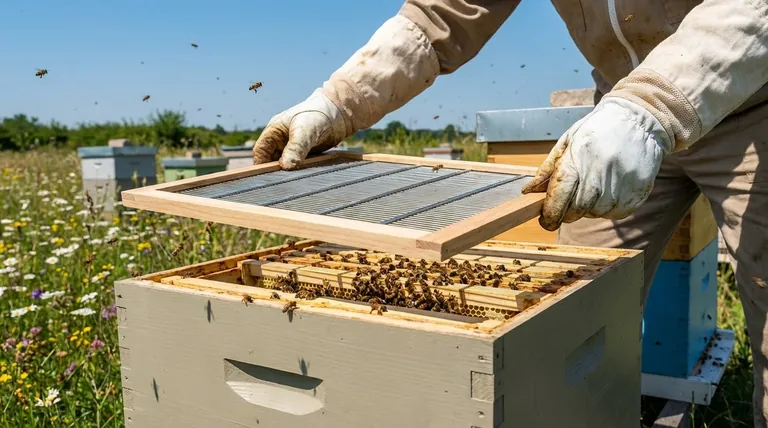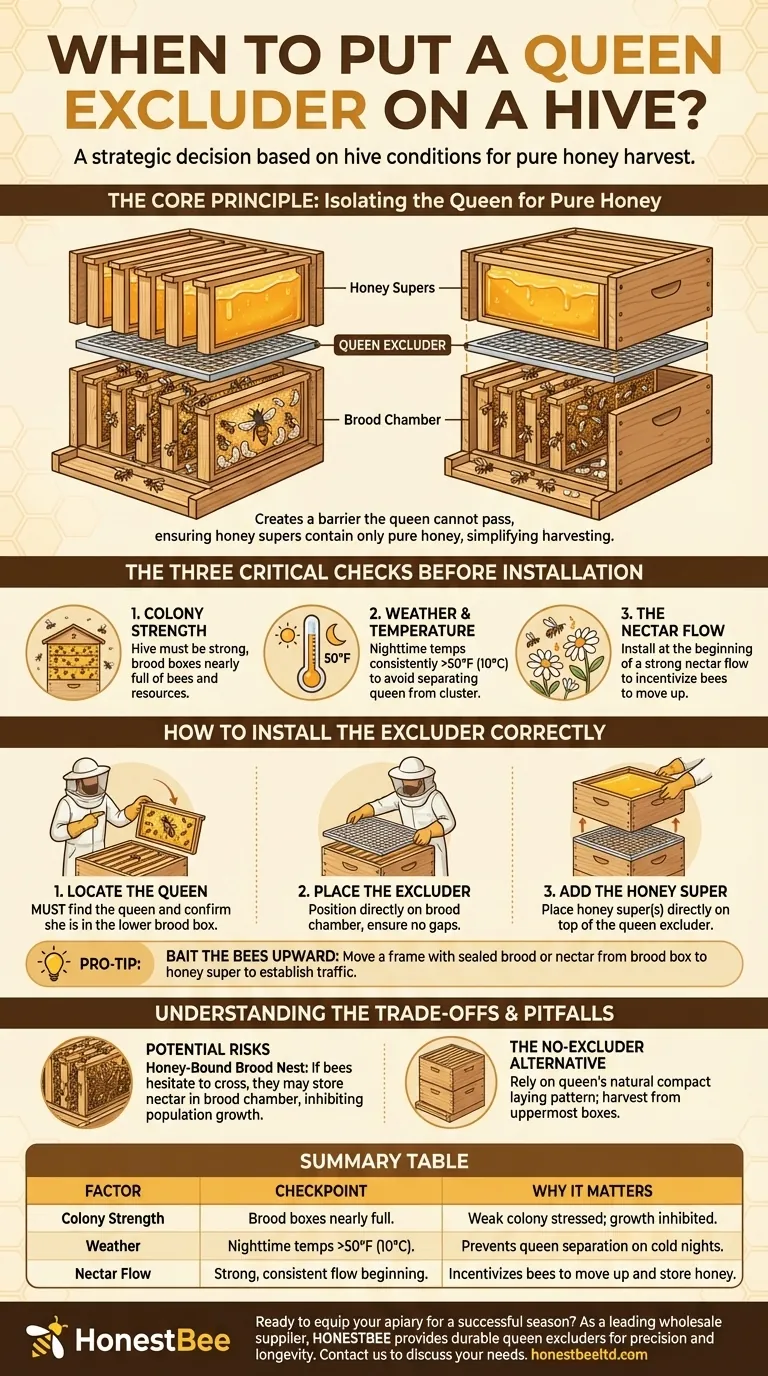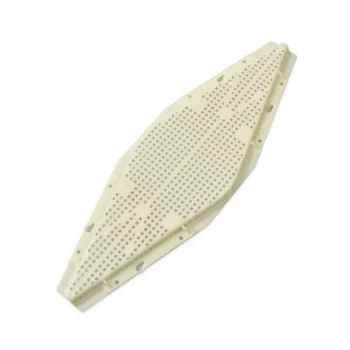The right time to add a queen excluder is when your hive is strong, the weather is consistently warm, and you are adding your first honey super of the season. This typically occurs in the spring, just as the main nectar flow begins. The goal is to install it before the colony expands upward, ensuring the queen remains in the lower brood boxes to lay eggs, leaving the upper supers dedicated exclusively to honey storage.
Using a queen excluder is a strategic decision based on hive conditions, not a fixed calendar date. It's less about when on the calendar and more about why—your colony is strong, the nectar is flowing, and you need to reserve space for pure honey.

The Core Principle: Isolating the Queen for Pure Honey
Your primary reason for using a queen excluder is to simplify honey harvesting. By creating a barrier the queen cannot pass, you ensure the frames in your honey supers contain only honey, not eggs, larvae, or pupae.
What a Queen Excluder Does
A queen excluder is a simple grid of metal or plastic. The openings are large enough for worker bees to pass through but too small for the larger queen and drones.
The Goal: Brood-Free Honey Supers
This tool confines the queen and her egg-laying activities to the brood chamber (the lower boxes of the hive). This keeps your honey supers "clean," making the extraction process much more straightforward.
The Three Critical Checks Before Installation
Before you place an excluder on your hive, you must verify that the colony is ready. Acting too soon can harm the hive's development.
Check 1: Colony Strength
A queen excluder should only be placed on a strong, populous hive. The brood boxes should be nearly full of bees, brood, and resources. Adding an excluder to a weak colony can inhibit its growth and stress the bees.
Check 2: Weather and Temperature
Install the excluder only when the weather has stabilized. Nighttime temperatures should consistently remain above 50°F (10°C). If installed too early, the excluder can trap the queen in the lower box, separating her from the main cluster of bees if they move up to stay warm on a cold night.
Check 3: The Nectar Flow
The ideal time for installation is at the beginning of a strong nectar flow. This gives the worker bees a powerful incentive to move through the excluder and begin storing honey in the supers above.
How to Install the Excluder Correctly
Proper installation is a quick process, but one step is absolutely critical to success.
Step 1: Locate the Queen
This is the most important step. Before placing the excluder, you must find the queen and confirm she is in the brood box you intend to keep her in. If you accidentally trap her in a honey super, she will begin laying eggs there, defeating the purpose of the excluder.
Step 2: Place the Excluder
Position the excluder directly on top of your designated brood chamber. Ensure it sits flat and covers the entire box, leaving no gaps around the edges where the queen could slip through.
Step 3: Add the Honey Super
Place your honey super (or supers) directly on top of the queen excluder.
Pro-Tip: Bait the Bees Upward
To encourage workers to quickly move past the new barrier, you can "bait" them. Move one frame containing sealed brood or nectar from the brood box up into the center of the honey super. This draws the nurse bees and foragers upward, establishing traffic through the excluder.
Understanding the Trade-offs and Pitfalls
While useful, queen excluders are not without their downsides. Understanding these helps you manage your hive more effectively.
It Can Create a Barrier
Some beekeepers feel that excluders can slow down worker bee movement, creating a "bottleneck" that may slightly reduce the speed of honey storage.
Risk of a Honey-Bound Brood Nest
If workers are hesitant to cross the excluder, they may begin storing excess nectar in the brood chamber. This can fill cells the queen needs for laying eggs, a condition known as being honey-bound, which can stifle colony population growth.
The No-Excluder Alternative
Many experienced beekeepers do not use excluders, especially in hives with two deep brood boxes. They rely on the queen's natural tendency to lay in a compact pattern, leaving the upper corners and top-most boxes for honey storage.
Making the Right Choice for Your Hive
Your decision should be based on your management style and goals.
- If your primary focus is guaranteed brood-free honey and simpler harvesting: Use a queen excluder once your hive meets the strength, weather, and nectar flow criteria.
- If you manage a very strong, rapidly expanding colony: Use the "bait frame" technique to ensure bees move upward and prevent the brood nest from becoming honey-bound.
- If you prefer a more natural approach with multiple brood boxes: You may choose to skip the excluder and simply harvest honey from the uppermost boxes, which are least likely to contain brood.
Ultimately, using a queen excluder is a tool to help you achieve a specific goal: clean and easy honey collection.
Summary Table:
| Factor | Checkpoint | Why It Matters |
|---|---|---|
| Colony Strength | Brood boxes are nearly full of bees and brood. | A weak colony will be stressed and growth inhibited. |
| Weather | Nighttime temps consistently above 50°F (10°C). | Prevents the queen from being separated from the cluster on cold nights. |
| Nectar Flow | At the beginning of a strong, consistent flow. | Gives bees a strong incentive to move up and store honey. |
Ready to equip your apiary for a successful season?
As a leading wholesale supplier to commercial apiaries and distributors, HONESTBEE provides the durable, reliable equipment you need to manage your hives efficiently. Our queen excluders are designed for precision and longevity, helping you achieve pure, brood-free honey harvests.
Let us support your operation's growth and productivity. Contact our team today to discuss your wholesale needs and explore our full catalog of beekeeping supplies.
Visual Guide

Related Products
- Premium Wood Framed Metal Wire Queen Bee Excluder
- Professional Plastic Queen Excluder for Modern Beekeeping
- Wooden Queen Bee Excluder for Beekeeping
- Plastic Queen Bee Excluder for Bee Hive Wholesale
- High Performance Plastic Queen Excluder for Beekeeping and Apiary Management
People Also Ask
- What is the purpose of a queen excluder? Achieve a Clean Honey Harvest & Organized Hive
- What is the primary function of a queen excluder? A Guide to Brood-Free Honey Harvesting
- What are the advantages of using queen excluders? Boost Honey Production & Hive Management
- What makes polyurethane foam environmentally friendly? The Surprising Benefits of a Durable, Inert Material
- Do I really need a queen excluder? A Guide to Maximizing Your Honey Harvest Efficiency



















